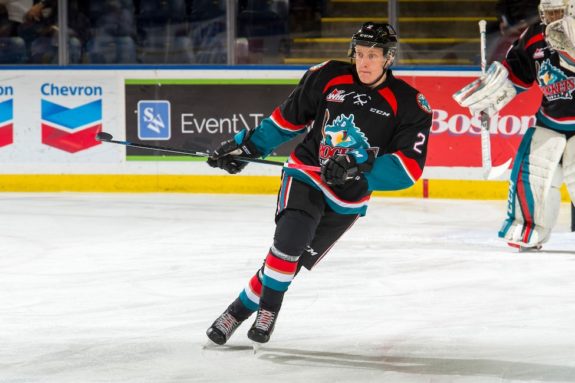In my last article, I highlighted why the Anaheim Ducksneed to draft a center with their No. 9 overall pick. Luckily, they have two first-round picks, No. 9 (their own) and No 29 (received in the Brandon Montour trade). That means they can address another organizational need, a potential top-four defenseman, later in the first round.
Ducks Need to Reload on Defense
One storyline of the Ducks’ last couple seasons has been general manager Bob Murray’s willingness to part with talented puck-moving defensemen. After trading Montour in 2018-19, Sami Vatanen in 2017-18 and Shea Theodore in the summer of 2017, it’s time for Anaheim to restock.
They aren’t in dire straits yet, with Hampus Lindholm, Cam Fowler and Josh Manson leading the pack. They also have Brendan Guhle, who they received in the Montour trade and Josh Mahura and Jacob Larsson to round out a strong group.
Lindholm and Manson are under contract for three more seasons. If they don’t re-sign, there aren’t any home-grown prospects to replace them with as high a ceiling coming along.

Plus, of those six players, Lindholm, Manson, Fowler, Guhle, Larsson and Mahura, only Manson is a right shot. Korbinian Holzer, Jake Dotchin and Andy Welinski are all right shots, but none are top-four defenseman, and all are free agents in some form.
Anaheim needs another future top-four defenseman. If they want to focus on a right-shot defender, they might need a little luck.
Lassi Thomson to the Ducks?
Of the players potentially available to the Ducks at No. 29, there should be a few future top-four defensemen. Only one shoots righty, and that’s Lassi Thomson. The other players who may be available, Ville Heinola, Matthew Robertson, Tobias Bjornfot, Alex Vlasic and Ryan Johnson are all left shots.
If Thomson is available, Anaheim should take him. However, since right-shot blueliners are in such short supply — realistically, there are only three who could go in the first round — other teams might be willing to reach for him from a higher position in the draft.
Another Fin on the Ducks Blue Line
According to our draft expert Ryan Pike, Thomson is an offensively talented defender with excellent skating ability and a tremendous offensive sense.
Being a right shot, Thomson could give Anaheim more options on their power play. He has a strong and accurate shot that also makes him a power play asset. Like defensemen the Ducks have traded and kept, Thomson is a great puck mover who can dance around defenders when he rushes the puck.

Thomson’s game sounds similar to Sami Vatanen’s when he entered the draft in 2009. You could argue that the Ducks waited until the fourth round to pick him, but that was a decade ago when size and strength were considered more significant factors in drafting a defenseman.
The 2018 draft saw nine of 18 defenders picked in the first round with a height of six feet or less. In 2009, there were only three defensemen selected in the first round who stood six-feet-tall or less – Ryan Ellis, Dmitri Kulikov and Nick Leddy.
Though he’s not huge, Thomson isn’t tiny either. In a league where teams will sacrifice size for skating talent and offensive ability on the blue line, worrying about the height of a six-footer sounds a little ridiculous – ask Erik Karlsson, Charlie McAvoy, Kris Letang or Vatanen.
Thomson’s major weaknesses – discipline and lack of strength – can be improved quickly, while his strengths – offensive instincts, strong shot and skating ability – are much harder to cultivate. Though he needs some work in his own end, pairing him with a shutdown defender like Fowler could mitigate that weakness.
Tobias Bjornfot for the Future?
There are multiple left-shot defensemen who look like they might be available for the Ducks at No. 29. Though Robertson sounded like a good option, it’s unlikely he will be available when the Ducks step up to the stage for the second time. If Bjornfot is still around, I’d take him.
Like Thomson, Bjornfot is a good skater, with a powerful shot and an excellent hockey sense. This is getting repetitive, isn’t it? The reason I would choose Thomson before Bjornfot is his right-handed shot, but Bjornfot may actually have a more well-rounded game because he’s considered better in his defensive zone. Bjornfot already has more strength than Thomson but could stand to add more.
He would also be an asset on special teams and could someday replace Lindholm or Fowler on the Ducks power play with his ability to distribute the puck and play penalty kill minutes, (which declined to the bottom-third of the league last season).
Bjornfot will be a good option for the Ducks if another team picks Thomson first. If they aren’t as committed to adding a right-shot defender early in the draft, they might even select him instead of Thomson.
Alex the Giant?
There’s usually a player or two in the draft who excites people for two reasons, size and potential. Vlasic is that player. At 6-foot-6, Vlasic is a monster, and anyone who watched St. Louis Blues defender Colton Parayko help shut down the Boston Bruins’ “perfection line” in the Stanley Cup Final knows the value of a big boy like that.
Though Vlasic is tabbed as a bit of a project, his potential makes him valuable. He’s already a good skater for his size, and he’s been complimented as a smart defensive defenseman. He has the potential to develop a devastating point shot with that height, although he hasn’t yet and needs to play a more physical game with his dominant size.
If Vlasic can develop that physicality, he could fill a significant weakness in Anaheim’s game, keeping opponents away from the front of the net. During the 2018-19 season, John Gibson had to stop point-blank opportunities regularly thanks to a porous Ducks net-front defense. The Ducks ranked as the NHL’s fifth-worst team in high-danger chances allowed at 815.

Though Murray’s time behind the bench helped improve that weakness, placing a big, physical body in that area can do wonders, even if it takes few years to get him there. It was clear, especially during Randy Carlyle’s tenure that opponents didn’t fear punishment in front of the net. With Vlasic defending the space in front of Gibson, opponents would have a lot less space at the very least.
Friday’s opening round of the NHL draft will go a long way in filling two needs for Anaheim. At No. 29, the Ducks can select from several strong defensive candidates, but if they prioritize picking a right-shot defender, those candidates would decrease dramatically.
All stats from Natural Stat Trick.